Giant trees and sugar thrones: Inside the dark world of fairy tales
Most fairy tales were written for adults. When Charles Perrault (1628-1703) was compiling the stories we know today as Cinderella, Little Red Riding Hood, and Puss in Boots, the very idea of “childhood” was relatively new. Or so we understand from French historian, Philippe Ariès, whose influential book Centuries of Childhood (1960), has dominated our thinking on this subject.
If Ariès is correct, and people recognised no discontinuity between children and adults until the 17th century, then we may assume that folk tales had equally diverse audiences. Although recent historians have challenged the idea that medieval society saw children as “little adults”, there’s no doubting these stories were intended as moral lessons, alerting listeners to the terrible fate that awaits those who disregard social, legal and religious conventions.
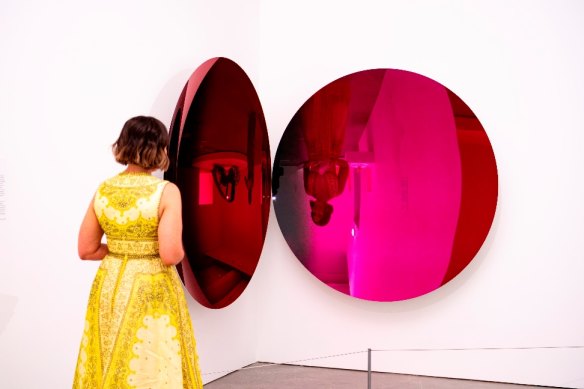
Anish Kapoor’s Red and Black Mist Magenta (2018).Credit: C Callistemon
It was in the 17th century, with writers such as Perrault and Madame d’Aulnoy (who gave us Goldilocks), that the fairy tale became sophisticated entertainment. It wasn’t until the 1800s, with the Brothers Grimm and Hans Christian Andersen, that these stories became associated with children. Nowadays, even if we believe fairy tales are only for kids, the most famous examples are part of popular culture, familiar to almost everyone.
In its historical evolution, the fairy tale has changed from a moral parable into a story that subverts every social convention. Famous historians of the genre, such as Jack Zipes and Marina Warner, would argue that this radicality has been present from the beginning, in the lurid and excessive nature of the stories, the consistent element of wish fulfilment, and the vision of a world turned upside down.
Often the tales seem to have gotten away from the teller. Look, for instance, at Carlo Collodi’s Pinocchio, ostensibly a warning to naughty children that they must obey their parents, but in reality a picaresque fantasy that fires the reader’s taste for adventure.
In recent decades, writers such as Robert Coover and Angela Carter have produced fairy stories that undermine every social nicety. If you find the Brothers Grimm too brutal, try reading Coover’s Briar Rose or Stepmother.
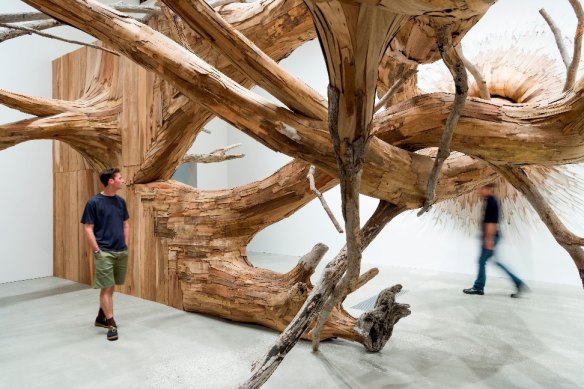
Henrique Oliveir’s Corupira, 2023.Credit: C. Callistemon
And so, when the Gallery of Modern Art (GOMA), hosts an exhibition called Fairy Tales in Art and Film, it opens up a vast, problematic box of toys. The initial problem for the curators, Amanda Slack-Smith and Sophie Hopmeier, was to choose artworks and movies from a super-abundance of material.
Their next dilemma was pure Goldilocks: the need to devise a survey that was not-too-dark and not-too-light. Veer too far in one direction and it’s a horror show, at the other pole it’s pure fairy floss.
They have managed to plot a reasonably successful course, although the over-indulgence in some areas is worrisome. Did we really need that many items from Tarsem Singh’s terrible movie of 2012, Mirror, Mirror? And how much Patricia Piccinini is too much?
On the most basic level, the show is consistently diverting, filled with all manner of paintings, sculptures, graphic works, installations, and audio-visual presentations. It’s accompanied by a magnificent film program that ranges from Benjamin Christensen’s Haxan: Witchcraft through the Ages (1922), to George Miller’s Three Thousand Years of Longing (2022).
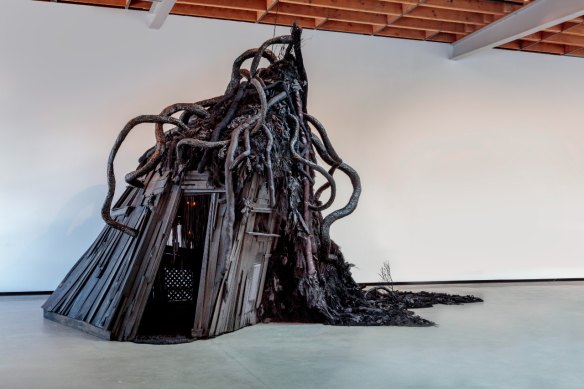
Season of the witch: Trulee Hall’s Witch House (Seance of the Umbilical Coven), 2020.Credit: Joshua White / JWPictures.com
The exhibition is divided into three sections: Into the Woods, Through the Looking Glass, and Ever After. In the first, the forest, where figures such as Hansel and Gretel or Goldilocks meet their fate, is viewed as a place of transformation. In the woods, the usual patterns of daily life are suspended. Those who enter, if they ever emerge, will be vitally changed by their experiences.
The most impressive work in this section is the first thing one meets upon entering the show: a gigantic installation by Brazilian artist, Henrique Oliveira, called Corupira, which engulfs the visitor in gnarled, twisting branches, made from real trees, enhanced with strips of plywood. It’s one of those rare pieces that justifies the detestable adjective, “indescribable”.
Other highlights include footage from Jean Cocteau’s Beauty and the Beast (1946); the dresses worn by Catherine Deneuve in Jacques Demy’s classic, Donkey Skin (1970); and a theatrical installation by American artist, Trulee Hall, called Witch House (Seance of the Umbilical Coven) (2020), which invites us to enter a black, ramshackle, impeccably Gothic hut, half-buried in creeping vines.
Amid all this spectacle, one may appreciate the oldest work in the show, Gustave Doré’s painting, Little Red Riding Hood (c.1862), on loan from the National Gallery of Victoria.
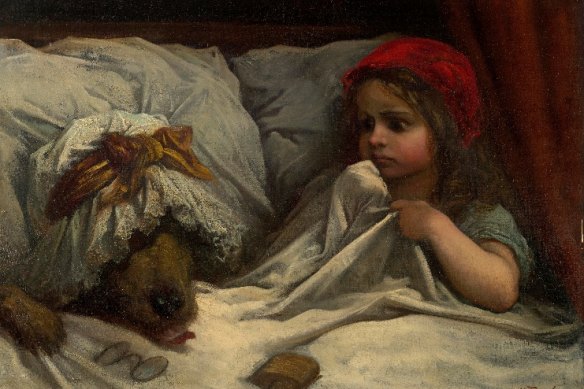
Gustave Doré’s Little Red Riding Hood, 1862.Credit: National Gallery of Victoria
It shows our heroine in bed, recoiling from the wolf dressed in grandma’s nightcap. In this melodramatic image, Doré has captured a vivid sense of menace, as we feel the little girl is on the brink of being ravaged by the beast.
Through the Looking Glass takes its cue from Lewis Carroll, featuring artists such as Charles Blackman, Jenny Watson, Polixeni Papapetrou and Tim Burton, who have made Alice in Wonderland-themed works.
The Blackman paintings are easily the most engaging, retaining a sense of wonder that draws us back into the world of the book in all its strangeness. The other artists take a more superficial approach. Tim Burton has made some great films, but Alice in Wonderland (2010), which feels as if it was mangled by the studio, is arguably the low point of his career.
When we hear the words Ever After, we instinctively think “Happily ever after”. It’s as much of a fairy tale formula as that famous opening line, “Once upon a time”. Slack-Smith says the abiding theme of this section is “love”, suggesting that at the end of the fairy tale the princess has found her prince, the lost child has been reunited with its family, evil has been vanquished and harmony restored to the community.
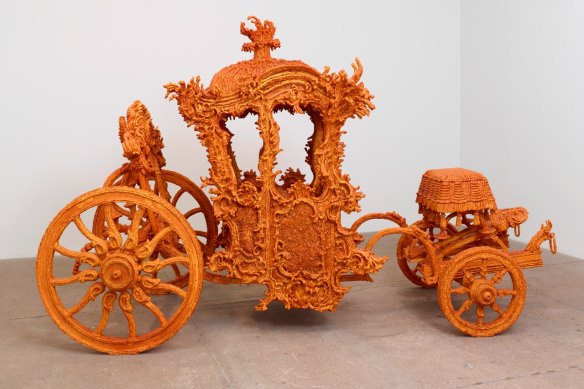
Timothy Horn’s Mother-load, 2008.Credit: Timothy Horn
It’s a thought that allows room for many different expressions, from Hans Christian Andersen’s original papercuts, often made to accompany story recitations, to Timothy Horn’s flamboyant, hyper-decorative sculptures of an oversized glass slipper, and an ornate sedan chair coated in crystallised rock sugar. Such pieces push the idea of kitsch into a new aesthetic dimension.
The Andersen cut-outs, on loan from Odense in Denmark, should be a tremendous drawcard, as should the “fairies at the bottom of the garden” photos of 1917-20, faked by two English teenagers, Elsie Wright and Frances Griffiths. We may feel that AI could do a better job, but the hoax was a big success in its day, even fooling Sir Arthur Conan Doyle, creator of Sherlock Holmes.
These small but potent works might have been the basis of an entirely different version of Fairy Tales, one that values intimacy and personal imagination over spectacle. There is little basis for comparison when we put a painting by Gustave Doré or a papercut by Hans Christian Andersen alongside the costumes for Spike Jonze’s film adaptation of Maurice Sendak’s Where the Wild Things Are (2009), or the props from Jim Henson’s Labyrinth (1986).
In this sense, Fairy Tales is as confused as the Art Gallery of NSW’s Japan Supernatural of 2019, in which older, smaller works were overshadowed by huge, eye-catching, contemporary confections.
In Fairy Tales, it may have been the generosity of the Academy Museum of Motion Pictures in Los Angeles, in lending so many of Eiko Ishioka’s original outfits from Mirror, Mirror, that led the curators to honour this dud movie with a starring role. So too with the endless array of grotesque-but-cute silicone figures by Patricia Piccinini. Readily available, they allowed an easy option for filling the cavernous corridor that divides the galleries on GOMA’s ground floor.
It’s obvious that public art museums need shows with the razzamatazz that appeals to the broadest possible audience, yet there’s no rule saying they need to do only one, sprawling compilation. Fairy Tales is a case of two shows awkwardly mashed together, in which good and bad, large and small, past and present, are forced to inhabit the same spaces.
A considered separation would have allowed greater clarity of reception, and a more in-depth treatment of the ideas suggested by the theme. In the way our art museums conceive major exhibitions there’s a long way to go before we’re out of the woods.
Fairy Tales in Art and Film is at the Gallery of Modern Art, Brisbane until April 28.
The Booklist is a weekly newsletter for book lovers from books editor Jason Steger. Get it delivered every Friday.